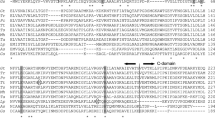Abstract
Crude extracts of wild-typeEscherichia coli contain two catalase species that separate on native polyacrylamide gels. The slow-migrating enzyme (HPII) has two pH optima of activity (at pH 6.8 and 10.5), is activated at 70°C, is sensitive to inhibitory by 3-amino-1,2,4-triazole and has Km values of 18.2 mM at pH 6.8 and of 10 mM at pH 10.5. The fast-migrating enzyme has a single pH optimum of 6.8 and is composed of two isozymes (HPI-A and HPI-B). Its activity is labile at 70°C, it is relatively resistant to inhibition by 3-amino-1,2,4-triazole and has a Km value of 3.7 mM.
Similar content being viewed by others
Literature Cited
Chance B, Sies H, Boveris A (1979) Hydroperoxide metabolism in mammalian organs. Physiol Rev 59:527–605
Claiborne A, Fridovich I (1979) Purification of the O-dianisidine peroxidase fromEscherichia coli B. J Biol Chem 254:4245–4252
Claiborne A, Malinowski DP, Fridovich I (1979) Purification and characterization of hydroperoxidase II ofEscherichia coli. J Biol Chem 254:11664–11668
Clare DA, Duong MN, Darr D, Archibald F, Fridovich I (1984) Effect of molecular oxygen on detection of superoxide radical with nitroblue tetrazolium and on activity stains for catalase. Anal Biochem 140:532–537
Hassan HM, Fridovich I (1978) Regulation of the synthesis of catalase and peroxidase inEscherichia coli. J Biol Chem 253:6445–6450
Hassan HM, Fridovich I (1979) Superoxide, hydrogen peroxide and oxygen tolerance of oxygen sensitive mutants ofEscherichia coli. Rev Infect Dis 1:357–366
Laemmli UK (1970) Cleavage of structural proteins during the assembly of the head of bacteriophage T4. Nature (Lond) 227:680–685
Loewen PC (1984) Isolation of catalase-deficientEscherichia coli mutants and genetic mapping ofkatE, a locus that affects catalase activity. J Bacteriol 155:622–626
Loewen PC, Triggs BL (1984) Genetic mapping ofkatF, a locus that withkatE affects the synthesis of a second catalase species inEscherichia coli. J Bacteriol 160:668–675
Loewen PC, Triggs BL, Klassen GR, Wiener JH (1983) Identification and physiological characterization of a ColE1 hybrid plasmid containing a catalase gene ofEscherichia coli. Can J Biochem Cell Biol 61:1315–1321
Loewen PC, Triggs BL, George CS, Hrabarchuk BE (1985) Genetic mapping ofkatG, a locus that affects synthesis of the bifunctional catalase-peroxidase HPI inEscherichia coli. J Bacteriol 162:661–667
Margoliash E, Novogrodsky A, Schejter A (1960) Irreversible reaction of 3-amino-1∶2∶4-triazole and related inhibitors with the protein of catalase. Biochem J 74:339–348
Meir E, Yagil E (1984) Catalase-negative mutants ofEscherichia coli. Curr Microbiol 11:13–18
Miler JH (1972) Experiments in molecular genetics. Cold Spring Harbor NY: Cold Spring Harbor Laboratory
Reich I, Sayar D, Hochman A (1984) Is catalase an enzyme without a pH optimum? Isr J Med Sci 20:482
Wayne LG, Diaz GA (1982) Serological, taxonomic, and kinetic studies of the T and M class of Mycobacterial catalase. Int J Syst Bacteriol 32:296–304
Author information
Authors and Affiliations
Rights and permissions
About this article
Cite this article
Meir, E., Yagil, E. Further characterization of the two catalases inEscherichia coli . Current Microbiology 12, 315–319 (1985). https://doi.org/10.1007/BF01567889
Issue Date:
DOI: https://doi.org/10.1007/BF01567889




